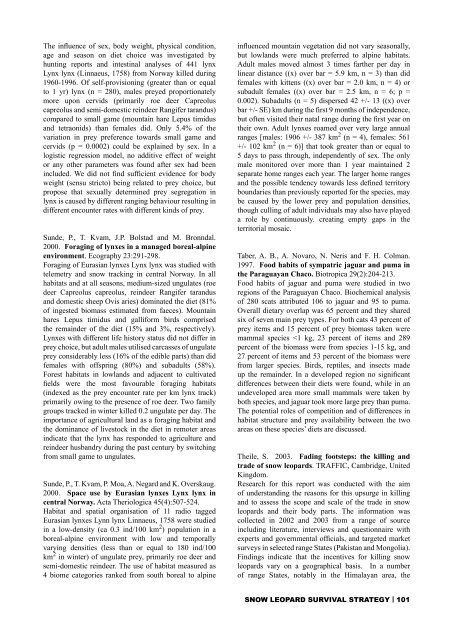Snow Leopard Survival Strategy - Panthera
Snow Leopard Survival Strategy - Panthera
Snow Leopard Survival Strategy - Panthera
Create successful ePaper yourself
Turn your PDF publications into a flip-book with our unique Google optimized e-Paper software.
The influence of sex, body weight, physical condition,<br />
age and season on diet choice was investigated by<br />
hunting reports and intestinal analyses of 441 lynx<br />
Lynx lynx (Linnaeus, 1758) from Norway killed during<br />
1960-1996. Of self-provisioning (greater than or equal<br />
to 1 yr) lynx (n = 280), males preyed proportionately<br />
more upon cervids (primarily roe deer Capreolus<br />
capreolus and semi-domestic reindeer Rangifer tarandus)<br />
compared to small game (mountain hare Lepus timidus<br />
and tetraonids) than females did. Only 5.4% of the<br />
variation in prey preference towards small game and<br />
cervids (p = 0.0002) could be explained by sex. In a<br />
logistic regression model, no additive effect of weight<br />
or any other parameters was found after sex had been<br />
included. We did not find sufficient evidence for body<br />
weight (sensu stricto) being related to prey choice, but<br />
propose that sexually determined prey segregation in<br />
lynx is caused by different ranging behaviour resulting in<br />
different encounter rates with different kinds of prey.<br />
Sunde, P., T. Kvam, J.P. Bolstad and M. Bronndal.<br />
2000. Foraging of lynxes in a managed boreal-alpine<br />
environment. Ecography 23:291-298.<br />
Foraging of Eurasian lynxes Lynx lynx was studied with<br />
telemetry and snow tracking in central Norway. In all<br />
habitats and at all seasons, medium-sized ungulates (roe<br />
deer Capreolus capreolus, reindeer Rangifer tarandus<br />
and domestic sheep Ovis aries) dominated the diet (81%<br />
of ingested biomass estimated from faeces). Mountain<br />
hares Lepus timidus and galliform birds comprised<br />
the remainder of the diet (15% and 3%, respectively).<br />
Lynxes with different life history status did not differ in<br />
prey choice, but adult males utilised carcasses of ungulate<br />
prey considerably less (16% of the edible parts) than did<br />
females with offspring (80%) and subadults (58%).<br />
Forest habitats in lowlands and adjacent to cultivated<br />
fields were the most favourable foraging habitats<br />
(indexed as the prey encounter rate per km lynx track)<br />
primarily owing to the presence of roe deer. Two family<br />
groups tracked in winter killed 0.2 ungulate per day. The<br />
importance of agricultural land as a foraging habitat and<br />
the dominance of livestock in the diet in remoter areas<br />
indicate that the lynx has responded to agriculture and<br />
reindeer husbandry during the past century by switching<br />
from small game to ungulates.<br />
Sunde, P., T. Kvam, P. Moa, A. Negard and K. Overskaug.<br />
2000. Space use by Eurasian lynxes Lynx lynx in<br />
central Norway. Acta Theriologica 45(4):507-524.<br />
Habitat and spatial organisation of 11 radio tagged<br />
Eurasian lynxes Lynn lynx Linnaeus, 1758 were studied<br />
in a low-density (ca 0.3 ind/100 km 2 ) population in a<br />
boreal-alpine environment with low and temporally<br />
varying densities (less than or equal to 180 ind/100<br />
km 2 in winter) of ungulate prey, primarily roe deer and<br />
semi-domestic reindeer. The use of habitat measured as<br />
4 biome categories ranked from south boreal to alpine<br />
influenced mountain vegetation did not vary seasonally,<br />
but lowlands were much preferred to alpine habitats.<br />
Adult males moved almost 3 times farther per day in<br />
linear distance ((x) over bar = 5.9 km, n = 3) than did<br />
females with kittens ((x) over bar = 2.0 km, n = 4) or<br />
subadult females ((x) over bar = 2.5 km, n = 6; p =<br />
0.002). Subadults (n = 5) dispersed 42 +/- 13 ((x) over<br />
bar +/- SE) km during the first 9 months of independence,<br />
but often visited their natal range during the first year on<br />
their own. Adult lynxes roamed over very large annual<br />
ranges [males: 1906 +/- 387 km 2 (n = 4), females: 561<br />
+/- 102 km 2 (n = 6)] that took greater than or equal to<br />
5 days to pass through, independently of sex. The only<br />
male monitored over more than 1 year maintained 2<br />
separate home ranges each year. The larger home ranges<br />
and the possible tendency towards less defined territory<br />
boundaries than previously reported for the species, may<br />
be caused by the lower prey and population densities,<br />
though culling of adult individuals may also have played<br />
a role by continuously. creating empty gaps in the<br />
territorial mosaic.<br />
Taber, A. B., A. Novaro, N. Neris and F. H. Colman.<br />
1997. Food habits of sympatric jaguar and puma in<br />
the Paraguayan Chaco. Biotropica 29(2):204-213.<br />
Food habits of jaguar and puma were studied in two<br />
regions of the Paraguayan Chaco. Biochemical analysis<br />
of 280 scats attributed 106 to jaguar and 95 to puma.<br />
Overall dietary overlap was 65 percent and they shared<br />
six of seven main prey types. For both cats 43 percent of<br />
prey items and 15 percent of prey biomass taken were<br />
mammal species
















